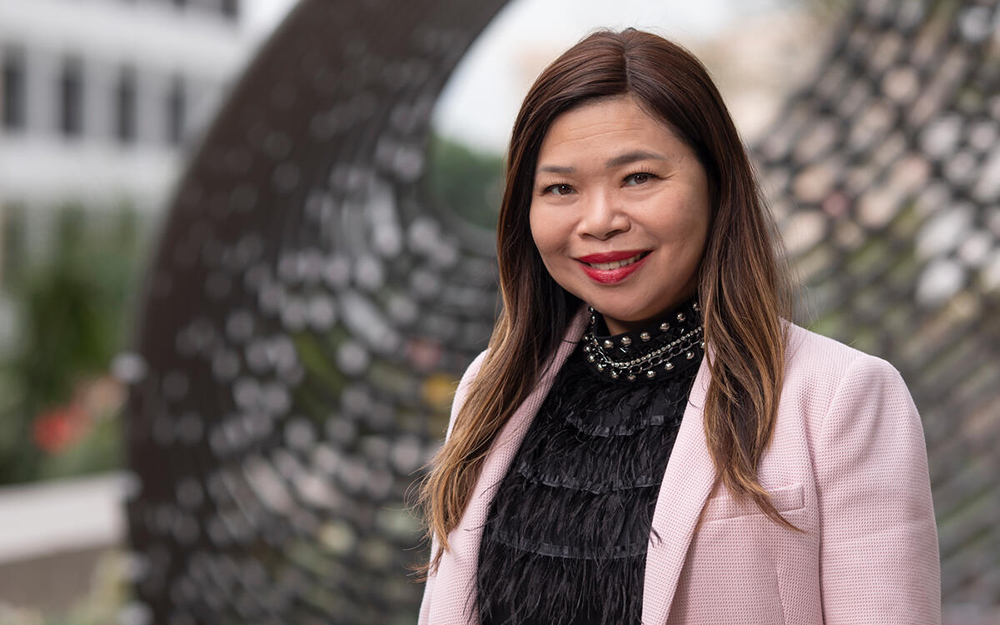Cedars-Sinai Blog
Caring Science: A Holistic Approach to Human Caring
Jan 11, 2024 Nicole Levine

Janette Moreno, DNP, RN, director of nursing practice, education and professional development at Cedars-Sinai
Nurses balance rigorous, evidence-based practice with compassion and human connection. Helping people through the most vulnerable moments of their lives is not a simple professional discipline.
Cedars-Sinai nurses follow an ethical and philosophical professional practice model that supports the emotional, mental and healing needs of themselves and their patients. The model is grounded in the theory of Caring Science, which was developed by Jean Watson, PhD, a renowned nurse theorist and professor.
“As nurses, we’re expert caregivers, and we must be alert at all times,” said Janette Moreno, DNP, RN, director of nursing practice, education and professional development at Cedars-Sinai. “We are abreast of every patient’s care plan, collaborating with doctors and responding to emergencies as they arise, all while providing calm and comfort to our patients at some of their most difficult moments.”
Caring Science, through its 10 Caritas Processes, offers nurses tools to care for themselves and their teammates in addition to the patients and families they serve. Many of these concepts are useful to anyone—not just bedside nurses in a busy medical center.
Moreno shared a few of these processes and how they can be applied to daily life.
Read: How to Stamp Out Burnout
Loving-Kindness Is the First Step
The first Caritas Process is practicing loving-kindness to oneself and others. Loving-kindness is mindfully offering compassion, care and affection, often simply by repeating supportive phrases in your mind.
“When we started rolling out Caring Science at Cedars-Sinai, we agreed that if there is one thing we must truly focus on, it is this first process of loving-kindness,” Moreno said. “The moment we truly integrate that into our practice, the rest of the Caritas Processes will flow.”
Loving-kindness was crucial early in the pandemic when many nurses were getting sick with COVID-19 while caring for patients who were isolated in the hospital and families who were unable to visit their loved ones.
Moreno likens offering loving-kindness to yourself to the well-known instructions given at the beginning of every airplane flight: In an emergency, put on your oxygen mask before assisting others with theirs.
Inspire Authenticity
The second process calls for being authentically present in each moment and being aware of the needs, beliefs and feelings of others.
Moreno says this practice reminds her of a quote from Watson, the creator of Caring Science: “Maybe this one moment, with this one person, is the very reason we are here on Earth at this time.”
We miss the present moment when we ruminate on the past, worry about the future, or otherwise let our thoughts wander away from the people we’re with and the actions we’re taking now.
“We must be mindful in this moment and this interaction with one person,” Moreno said. Nurses practice this each time they walk into a patient’s room: Their focus becomes the person in front of them.
"We build on our kindness to ourselves, our authenticity and our sensitivity to others to be the calm in any situation. We are the healing environment."
Create the Healing Environment
The physical realities of the environment—clean linens, beds, necessary supplies stocked and close at hand, a comfortable temperature—are only some of the requirements for a healing environment. The people in that environment—their talents, insights and attitudes—are also crucial.
“We build on our kindness to ourselves, our authenticity and our sensitivity to others to be the calm in any situation,” Moreno said. “We are the healing environment.”
Self-awareness about how we affect the people and events around us is essential to everyone, she said. Choosing to contribute to a serene environment can be a challenge, especially in times of chaos and change.
Recognizing our own role in creating an environment that allows others to heal and thrive is a powerful step.
Read: The Science of Kindness
Be Open to Hope
The last of the processes challenges practitioners to be open to the unknown and life’s infinite possibilities.
“It’s hope, and it’s what everybody needs,” Moreno said.
In hospitals and outside of them, we all encounter times when we have done everything we can do, and yet we don’t get the outcome we most desired.
“We feel frustrated when we cannot do anything else for a patient,” she said. “Sometimes we bottle it up. We can feel like we failed. Creating a strong community and finding a sliver of hope is what keeps us together.”
Cedars-Sinai nurses have adopted a shared vision that they sum up in a few words: Excellence in Human Caring. Caring Science offers a useful toolbox to further that endeavor.
“We ask our nurses to have innovative and creative minds,” Moreno said. “We ask them to be inspired to do great, lifesaving work and teach others. We ask them to be the healing environment and to provide dignity and respect to each patient. With our professional practice model, we’ve also empowered them to say it’s truly OK for each of us to take care of ourselves, so that we can do all those other things and do our very best every day.”

